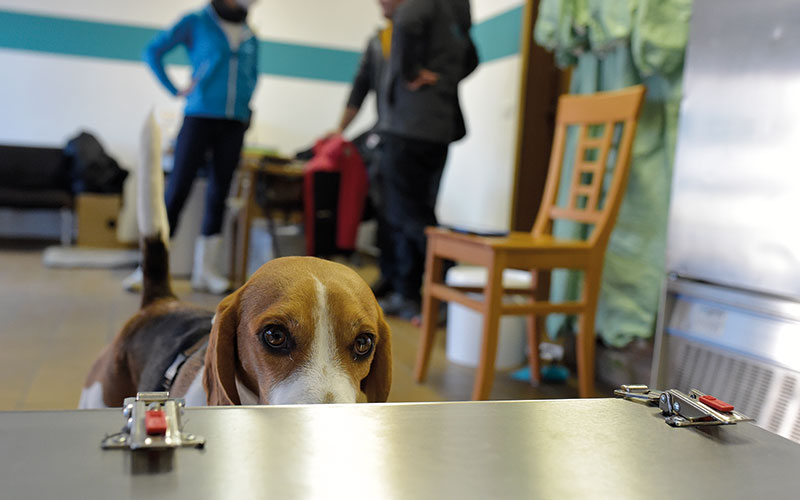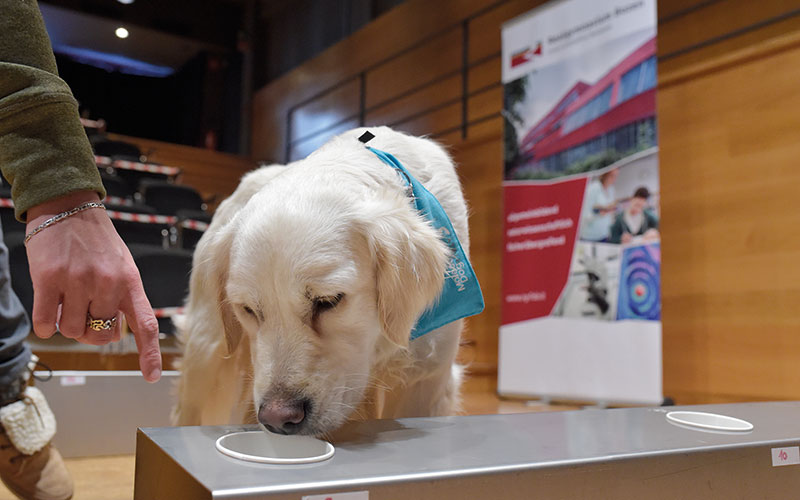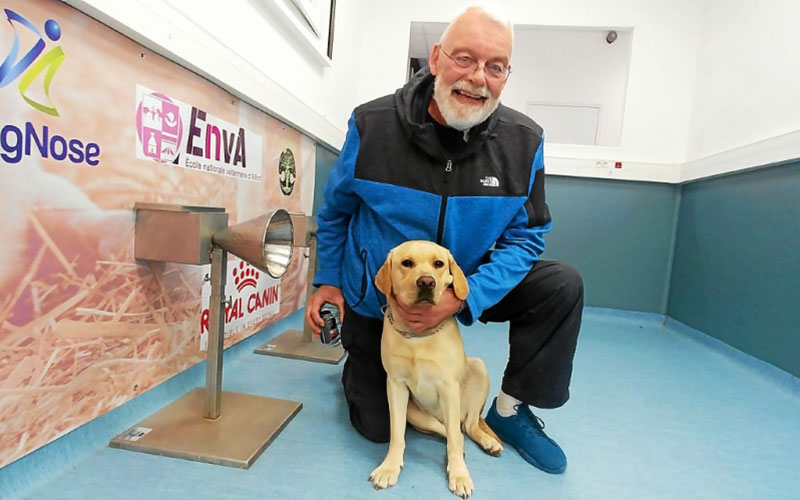Specially trained dogs can detect COVID-19 from sweat, which has implications for how testing takes place in a places, such as airports, explains vet and researcher, Dominique Grandjean.

The idea that dogs could sniff out disease was first suggested by Hywel Williams and Andres Pembroke in 1989 in relation to melanoma. Numerous studies demonstrating how effective dogs’ olfactory senses are in detecting tumours for a range of cancers and in preventing crises for diabetic and epileptic people have followed.
Now researchers are using dogs to detect COVID-19 and the findings of one study suggests canine olfactory function is more accurate than many fast lateral flow tests (LFTs) in identifying the virus in humans. Researchers at France’s national veterinary school in Alfort and the clinical research unit of the Necker-Cochin Hospital, Paris, set out to demonstrate whether the sweat produced by people who tested positive for the virus differs in odour from the sweat of people without COVID-19, and whether dogs could be trained to detect this.
The Nosaïs COVID-19 research project, which took place across three different sites in France and Lebanon, took 198 swab samples of auxiliary sweat that had been provided by people coming to be tested for the virus at Parisian screening centres. Of the samples, 101 were positive samples and 97 were negative for COVID.
The animals – 18 dogs (mainly Belgian Malionois Shepherds) trained in explosive detection, firefighter search and rescue and colon cancer detection – were imprinted with the odour from positive COVID-19 samples. The idea is that the dogs, with 300 million olfactory receptors in their noses, compared with six million in humans’ noses, could be trained to detect this “signature” of volatile organic compounds associated with COVID-19.
There was no direct contact between dog and sample while they learned to discriminate between positive and negative samples that were contained in olfaction cones, and they were awarded a toy for each correct identification. “A dog needs roughly one tenth of a second to catch the odour he is looking for, and he does that as a game,” says Dr Dominique Grandjean, Professor at the national veterinary school, who helped lead the research project.
“Highly significant” findings
The dogs sniffed between four and 10 sweat swabs that were positive for COVID-19, and it took them between one and four hours to learn to detect the specific odour. In order to find further proof of the effectiveness of the canine training, eight of the dogs performed a total of 368 trials to adapt to the sample scenting. The study was fully blind.
In a line of several other negative samples or mock samples, four dogs found the positive sample 100% of the time, and the remaining dogs found the COVID-19 sweat swab 83%, 84%, 90% and 94% of the time – all significantly different from the percentage of success that would be obtained by chance alone. On average, the dogs could detect the presence of COVID-19 with 97% accuracy and were correct in identifying negative samples 91% of the time.
“The dogs show a sensitivity of 97% and a specificity of 91% of the whole tested cohort, and it goes up to 100% and 94% for the asymptomatic group. These results are highly significant,” says Grandjean, who is Head of the Breeding Department, Pathology of Equines and Carnivores and Director of the Animal Husbandry and Sport Medicine Unit at the national veterinary school, and a Colonel Veterinarian at the Paris Fire Brigade.
An alternative to LFTs

By comparison, a review of 64 studies from the Cochrane Library showed that LFTs demonstrate an average 72% accuracy in detecting COVID-19 and 58% accuracy in detecting negative COVID-19 tests.
According to Grandjean it appears that dogs are more effective at detecting COVID-19 than LFTs, “but the goal was not a competition, it was to see if dogs could be a help and a reliable test of COVID-19”.
“These are excellent results, comparable with those obtained with the reference test,” says Grandjean’s fellow lead researcher, Professor Jean Marc Tréluyer, Head of Service at the Clinical Pharmacology Department at the Necker-Cochin Hospital. “But the test with dogs is not meant to replace it, but rather to target people who should benefit from virological screening and facilitate mass screening because of the rapid response of dogs.”
Implications
The confirmation that dogs can detect the olfactory signature of COVID-19 could see sniffer dogs deployed to screen for the virus in crowded places – an ongoing focus of Grandjean’s research.
One of the main challenges in deploying dogs to detect the virus is training enough animals to be able to do it, he explains. “We need to obtain the rapid collaboration of all the administrations involved in dog olfactory detection (the Army, Police, Firefighters, Customs), to organise the training and build up a kind of pyramid of dog training in France.”
The French authorities are working with the Nosaïs research group on a programme to deploy dogs to identify
the presence of COVID-19, which may deploy dogs to sniff humans directly, but more training is still needed in this area, Grandjean explains. “We are actively working with the Marseille firefighters (BMPM) [on training dogs to sniff people] so that trains, aeroplanes and boats can be checked [for the presence of COVID-19].”
The study concludes: “In a context where, in many countries worldwide, diagnostic tests are lacking, in order to set up a mass detection of COVID-19 contaminant people, we think it is important to explore the possibility of introducing dog olfactive detection as a rapid, reliable and cheap ‘tool’ to either pre-test willing people or be a fast checking option in certain circumstances.”

1975–1979, doctorate, veterinary medicine, Ecole nationale vétérinaire d’Alfort [Alfort National Veterinary School], France
1980–present, Head of Breeding Department, Pathology of Equines and Carnivores, Director of the Animal Husbandry and Sport Medicine Unit, Ecole nationale vétérinaire d’Alfort [National Veterinary School of Alfort], France
1992–present, Colonel Veterinarian, Paris Fire Brigade.
Image credit | Getty




